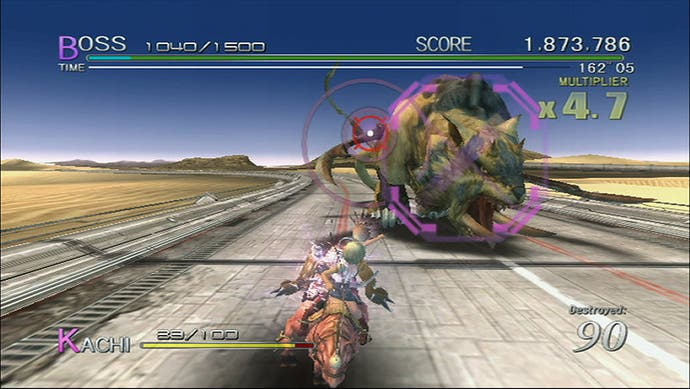Sin and Punishment: Successor of the Skies
Heavens above.
Each stage is filled with set-pieces, boss fights and snapshot views that clamber over one another for attention in the memory. And while the visual ideas in these set-pieces are distinct and inventive, the real delight is the way in which Treasure uses each to twist expectation and play with the basic mechanics.
In one area a hulking boss in the middle distance hurls crates at you as you take pot shots at it from afar. The crates disappear from view on their incoming trajectory, before descending from the top of the screen as Tetris blocks, slowly obscuring the view of your foe. So you are tasked with clearing the foreground space while maintaining an awareness of your target in the background. Occasionally a red crate falls which, when destroyed, will shoot dangerous flames off in the four directions of the compass, Bomberman-style. This adds a third layer of complexity to the moment, as you are forced to consider your character's position on the play field as well. The scene lasts a couple of minutes and the idea isn't repeated again.
This is vintage Treasure: an embarrassment of inventive riches that surprise, delight and challenge in equal measure, painting their rivals and indeed much of the gaming industry as bankrupt of imagination.
A 20-foot skeleton that plays basketball with a cluster of purple, disembodied ghouls' heads; ninja frogs crouch in a tall-grassed field demanding you shoot away the blades of grass to uncover where the shuriken-throwing creatures lurk; you traipse through a dark forest, a torch bolted to your gun, cutting swathes of light and destruction with each sweep of the Wiimote across the screen; a giant chicken squeezes out chicks that try to knock you over. Not spoilers, but hints to the litany of extravagant, memorable moments that barrel towards you.

As with so much of Treasure's output, high scores are where the longevity lies. Die and it's an immediate Game Over, the choice to continue returning you to the most recent checkpoint but resetting your score in the process. Online leaderboards exist for each stage across each difficulty level and are grouped by region, country and continent, so there's plenty of challenge for those who want to squeeze every last point from the experience. If there's any criticism to be made, it's in the length of each level, as it will take practice to make it through each 20 minute-long segment without using a continue on even the easiest difficulty level.
But that is also the game's strength. It is the antithesis to current fashions, where anyone can plough through a game without much need to learn or improve, where external reward systems take the pressure off creative level design, where games are broken into commercial break sized chunks, and slipped down with spoonful-of-sugar achievement points or trophies.
Here the rewards are rich, satisfying and threaded in the design. The compulsion to play through the game has not been found in manipulative shortcuts, but in graft and execution and a plethora of ideas. It is expensive game-making, for sure, but it is game-making at its absolute best. So Sin and Punishment 2 is videogame distilled, a fearsome concentrate to confound and delight, a suckerpunch reminder of what is possible in the medium if you choose not settle upon one brilliant idea, but instead embrace ten thousand.









